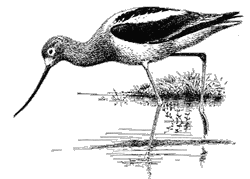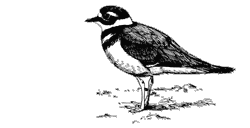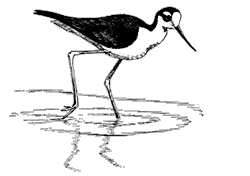Shorebirds
Shorebirds in general do most of their foraging along the water’s edge, probing in soft mud or picking at the surface in search of tiny invertebrates. They belong to several related families. The largest shorebird group is the sandpiper family (Scolopacidae); nearly two dozen species of sandpipers migrate through the Sonoran Desert, but for the most part their presence with us is fleeting, a few days’ stopover as they travel between breeding grounds on Arctic tundra and wintering grounds on southern coasts. More relevant here are two long-legged waders and one plover that are with us for much of the year.
 |
The avocets and stilts make up a small family, with only a few species worldwide. All are slim birds with long necks, thin bills, very long legs, and striking patterns. All forage in shallow water, feeding on small invertebrates. North America has one avocet and one stilt. Both have ranges which extend into the Sonoran Desert, where they seem to have benefited from human activity; most of their modern nesting sites are around the edges of artificial ponds.
Members of the plover family have distinctively short bills and short necks. When foraging they often run a few steps and then pause, and then run a few more, stopping now and then to pick up something from the ground. Although many plovers stick to typical shorebird haunts such as beaches and mudflats, a few thrive in dry fields, far from water. The Killdeer, our most familiar plover, is intermediate in its choice of habitats. Elsewhere it is common on farm fields and large lawns, but in desert regions it is usually not too far from water.
—Kenn KaufmanShorebirds
 |
Representative Sonoran Desert species:
Killdeer (Charadrius vociferus)
Black-necked Stilt (Himantopus mexicanus)
American Avocet (Recurvirostra americana)
Order: Charadriiformes
Families: Charadriidae (Killdeer), Recurvirostridae (Stilts and Avocets)
Spanish Names: tildío (Killdeer), avoceta (Stilts and Avocets)
Distinguishing Features
The plover family, to which Killdeer belong, are distinguished by their pigeon-like bills; Stilts and Avocets have slender bills (curved upward in the case of Avocets) and very long legs, the Stilt’s being “grotesquely long” according to The Peterson Field Guide to Western Birds. Their color patterns are also distinctive.
Habitat
These shorebirds inhabit the shorelines of lakes, ponds, rivers, and seas. The Killdeer, which is common throughout the year, lives in open, irrigated farmlands or in fields far from water. The avocet and stilt occur widely in migration, but withdraw from most of our area in winter.
Feeding
 |
• Diet: Though these birds will eat aquatic vegetation or seeds, insects and tiny crustaceans make up the majority of their diet.
• Behavior: These birds are active feeders, often foraging in groups, often rather noisily. Their feeding behavior is fun to watch. Killdeer find their food visually in the mud of fields or shores. The Black-necked Stilt walks about in shallow water or on the shore, picking up insects. And the American Avocet finds its food by feel beneath the water, using its bill to sweep in front of it as it walks along.
Life History
These 3 species draw attention to themselves with their loud and idiosyncratic cries. These are ground-nesting birds, whose eggs are well camouflaged and whose downy chicks can run about and find their own food shortly after hatching. Adults defend eggs or chicks with a repertoire of distraction displays. All 3 birds are good runners and strong flyers.